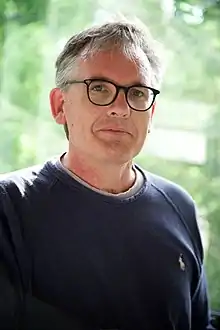David Poeppel
David Poeppel (born 1964 in Freiburg, Germany)[1] is Professor of Psychology and Neural Science at New York University (NYU).[2] Since 2014, he is also the Director of the Department of Neuroscience at Max Planck Institute for Empirical Aesthetics (MPIEA).[3] In 2019, he co-founded the Center for Language, Music and Emotion (CLaME)[4] an international joint research center, co-sponsored by the Max Planck Society and New York University.

David Poeppel | |
|---|---|
| Alma mater | Massachusetts Institute of Technology |
| Occupation | Professor of Neuroscience |
Biography
He grew up in Munich, Germany, Cambridge MA, USA and Caracas, Venezuela. Poeppel received his Abitur from the Maximiliansgymnasium in Munich, obtained his bachelor's degree (1990) and doctorate (1995) from Massachusetts Institute of Technology MIT. He received training in functional brain imaging as a postdoctoral fellow at the School of Medicine of the University of California, San Francisco. From 2000 to 2008, Poeppel directed the Cognitive Neuroscience of Language Laboratory at the University of Maryland College Park, where he was a professor of linguistics and biology.[5] He joined New York University[6] in 2009.
He was a fellow at the Wissenschaftskolleg zu Berlin and has been a guest professor at several institutions. He has received the DaimlerChrysler Berlin Prize of the American Academy of Arts and Sciences[7] and other honors.
He is the son of Prof. Dr. Ernst Pöppel.[8]
Research
David Poeppel is a researcher who employs behavioral and cognitive neuroscience approaches to study the brain basis of auditory processing, speech perception and language comprehension. The research in Poeppel's laboratory addresses questions such as: What are the cognitive and neuronal “parts lists” that form the basis for language processing, the fundamental constituents used in speech and language? How is sensory information transformed into the abstract representations that underlie language processing? What are the neural circuits that enable language processing?
Well-known contributions of the Poeppel laboratory include: the functional anatomic model of language developed with Greg Hickok;[9][10][11] research on lateralization in auditory processing;[12][13] and experimental work on the role of neuronal oscillations in audition and speech perception.[14][15] He also writes and lectures about methodological questions at the interdisciplinary boundary between cognitive science research and brain research.[16]
References
- Website Max Planck Gesellschaft
- Website New York University
- Website Max Planck Institute for Empirical Aesthetics
- Website CLaME,
- Website American Academy
- Website NYU
- Website American Academy
- Website Ludwig-Maximilians-Universität
- Hickok, G. and Poeppel, D. (2000). "Towards a Functional Anatomy of Speech Perception". Trends in Cognitive Sciences 4:131-138
- Poeppel, D. and Hickok, G. (2004). "Towards a new functional anatomy of language". Cognition 92, 1-12.
- Hickok, G & Poeppel, D. (2007). "The cortical organization of speech processing". Nature Neuroscience Reviews 8: 393-402.
- Poeppel, D. (2003). "The analysis of speech in different temporal integration windows: cerebral lateralization as ‘asymmetric sampling in time’". Speech Communication 41: 245-255.
- Boemio, A., Fromm, S., Braun, A., Poeppel, D. (2005). "Hierarchical and asymmetric temporal sensitivity in human auditory cortices". Nature Neuroscience 8: 389-395.
- Luo, H. and Poeppel, D. (2007). "Phase Patterns of Neuronal Responses Reliably Discriminate Speech in Human Auditory Cortex", Neuron. 54, 1001-1010
- Giraud, AL & Poeppel, D. (2012). "Cortical oscillations and speech processing: emerging computational principles and operations". Nature Neuroscience. 2012 March 18. doi: 10.1038/nn.3063.
- Poeppel, D (2012). "The maps problem and the mapping problem: Two challenges for a cognitive neuroscience of speech and language". Cognitive Neuropsychology. 29(1-2):34-55.